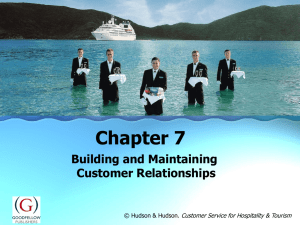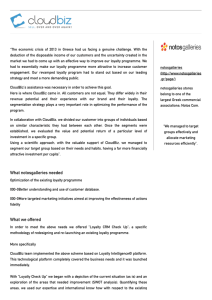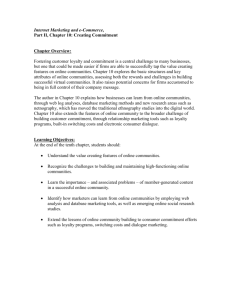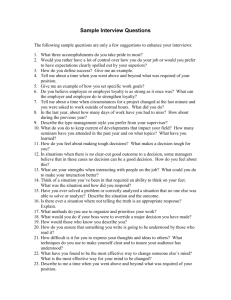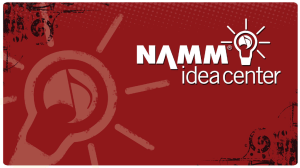How Brands, Consumers, and Platforms Can Win
advertisement
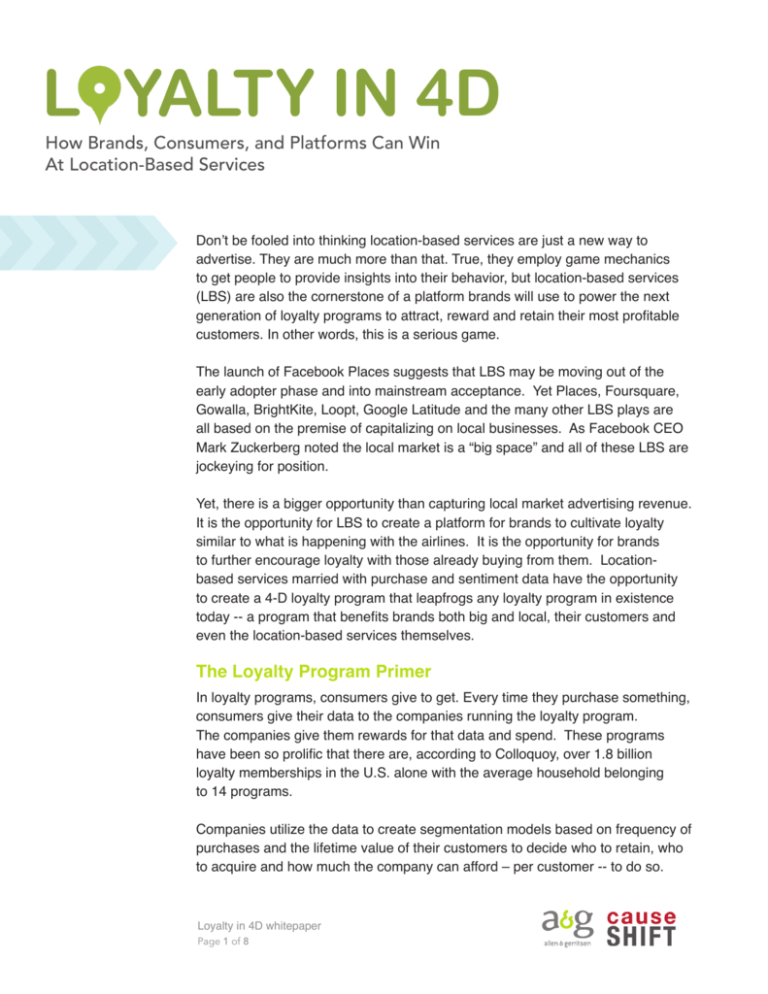
How Brands, Consumers, and Platforms Can Win At Location-Based Services Don’t be fooled into thinking location-based services are just a new way to advertise. They are much more than that. True, they employ game mechanics to get people to provide insights into their behavior, but location-based services (LBS) are also the cornerstone of a platform brands will use to power the next generation of loyalty programs to attract, reward and retain their most profitable customers. In other words, this is a serious game. The launch of Facebook Places suggests that LBS may be moving out of the early adopter phase and into mainstream acceptance. Yet Places, Foursquare, Gowalla, BrightKite, Loopt, Google Latitude and the many other LBS plays are all based on the premise of capitalizing on local businesses. As Facebook CEO Mark Zuckerberg noted the local market is a “big space” and all of these LBS are jockeying for position. Yet, there is a bigger opportunity than capturing local market advertising revenue. It is the opportunity for LBS to create a platform for brands to cultivate loyalty similar to what is happening with the airlines. It is the opportunity for brands to further encourage loyalty with those already buying from them. Locationbased services married with purchase and sentiment data have the opportunity to create a 4-D loyalty program that leapfrogs any loyalty program in existence today -- a program that benefits brands both big and local, their customers and even the location-based services themselves. The Loyalty Program Primer In loyalty programs, consumers give to get. Every time they purchase something, consumers give their data to the companies running the loyalty program. The companies give them rewards for that data and spend. These programs have been so prolific that there are, according to Colloquoy, over 1.8 billion loyalty memberships in the U.S. alone with the average household belonging to 14 programs. Companies utilize the data to create segmentation models based on frequency of purchases and the lifetime value of their customers to decide who to retain, who to acquire and how much the company can afford – per customer -- to do so. Loyalty in 4D whitepaper Page 1 of 8 But there are holes in the data. Unless a brand is able to get to related category purchase level data of their customer, they have to guess what their customers are doing when they are not spending with them. Of course, there are great listening tools like focus groups, surveys and even Twitter, but what if the customer had the opportunity to give companies the full story? To supply “extra” data about how they spend their day? LBS Creates a New Sense of Place That extra data comes in the form of “check-ins” – geographic tagging of a person’s specific location often coupled with likes and dislikes that are socially shared. Thanks to the recent emergence of location-based services, millions of users are recording their daily adventures and broadcasting their digital breadcrumbs to their social graph. According to the most recent published statistics, Brightkite claims more than five million users (we question this number), Foursquare is over three million strong while the others have been less forthcoming about their user base. Dennis Crowley also stated on a recent Sirius radio program that Foursquare took a year to get to one million users and a mere three months to break two million. Days later, they surpassed three million. These numbers will surely grow significantly with Facebook Places becoming available eventually to all of its 500+ million users. Up to this point, individuals have used LBS in large measure for the gaming and social sharing aspects. While there are occasional rewards attached to these check-ins, for the most part, users check in for the right to claim the title of “mayor”, find virtual items and earn recognition badges. These social gaming hooks have helped but short term rewards are not what will fuel the continued growth of LBS. The Limits of Check-Ins Alone The value of a check-in for a brand is less clear. That debate has been simmering long before the release of Forrester’s report recommending brands wait it out. A few brands, though, have been trying to find the value through experimentation. Ben and Jerry’s offered three scoops of their ice cream for three bucks (normally north of five dollars) and a free scoop for the mayor on Foursquare. The Gap offered 25% off of a purchase just for checking in. Best Buy teamed with Gowalla to check in for a chance to win a free eye-fi card. Loyalty in 4D whitepaper Page 2 of 8 Yes, these have generated excitement, but they only scratch the surface of what’s possible. More importantly, they are based entirely on frequency of visit. Check-ins are not enough; showing up doesn’t equate to profit. A customer might be checking in without purchasing anything. Or, they might be purchasing but their purchases are small, deeply discounted, or just a one-off because they are loyal to a competitor. Additionally, the points are tied to a specific location not all of a brand’s locations. So, for instance, if a customer frequents multiple Starbucks, they will never become a Foursquare Mayor – even though they may be a very profitable and loyal customer. 4-D Loyalty: Customer, Spend, Location and Sentiment Today, loyalty programs are siloed and limited to the interactions between two axes: customer and spend. In the best of these programs, a brand knows exactly what the customer is spending and how frequently. While they have spend data across all of their locations, brands do not know what the customer is doing at their competitors or related companies. If location-based services began collecting the size and frequency of purchases across all locations and mining the data of the check-ins (including the likes and dislikes), they could begin to build the next generation of loyalty rewards programs – a 4-D loyalty program comprised of customer, spend, location and sentiment. Such a program would benefit LBS providers, brands and customers alike. This full view of location could be gleaned from location-based services. For instance, if we go to Starbucks every day and purchase a latte and then walk across the street to Dunkin Donuts and pick up a turkey sausage flatbread, Starbucks and Dunkin Donuts both could benefit from that information. If many of their customers also go across the street for a flatbread, Starbucks could add a similar breakfast sandwich to their morning offerings or discontinue their current breakfast fare at that location. That level of data provides a more holistic view of consumer behavior, which can help brands cultivate customer loyalty by being more relevant and timely. In the example above, in addition to Starbucks knowing that we go across the street to purchase a breakfast sandwich, Starbucks could also learn whether we go to Starbucks all or most of the time for coffee. While we might not purchase food at Starbucks, we are still loyal and profitable customers. Starbucks could use that market insight to offer us promotions to try their food items instead of giving us promotions for coffee, which we already purchase at full price. Giving us promotions to buy what we already buy, loses money for the company. But, a promotion to shift our behavior becomes an incremental win for Starbucks. As consumers, we win because the brands we like can reward us with incentives to meet our needs better. Loyalty in 4D whitepaper Page 3 of 8 Location and Sentiment - Where Three Streams Converge The Holy Grail is found at the collision of the three activity streams: Hundreds of millions of people are constantly providing expressions of consciousness and professional expressions using Twitter and Facebook. This is the conversation stream. A smaller set of people are adding to these conversation streams by checking in to places on Foursquare, Gowalla, Brightkite, Loopt, Whrrl, Pegshot, Triout, Google Places and now, Facebook Places. We call this the location stream. The technology, though not very widely adopted yet, exists to capture and share every single non-cash purchase made in applications like Blippy and Swipely. This is the purchase stream. The conversation stream provides the attitudinal profile for the consumer and more. We not only learn their interests and their profession, but who their friends are, who influences them and what brands they are willing to interact with. Loyalty in 4D whitepaper Page 4 of 8 The location stream tells us where they actually go. We learn about brand stickiness and place loyalty. The purchase stream tells us what brands they purchase, whether they remain loyal to brands or are offer-sensitive and gives us a coveted look at the size of their wallet and the share by each brand. Getting to 4-D Loyalty: What if Foursquare Bought Blippy? Blippy provides the ability to share your purchases with your social graph, but these expressions have been viewed like an ugly peacock even by oversharing early adopters. Twitter’s API allows easy integration to any application. Foursquare’s API is equally lightweight and simple. The location-based service that buys Blippy or Swipely gains a significant advantage over the competition. Not only do they have location-based data, they will have type and frequency of purchases, amount of spend per visit and over time and better hypothesis at size of wallet that will allow brands to create the best targeted offers to customers using LBS. A Retail Scenario It makes no sense to offer a customer a discount on items that they will purchase at the regular price. For retail, knowing the list of most frequently purchased items across all stores is enormously beneficial. Knowing “the usual” yields a necessity rating for products that is made up of frequency of purchase, price sensitivity and propensity to purchase with our store versus elsewhere. It can also show things like specific brand loyalty versus price sensitivity (think Smuckers versus store brand jelly). The ability to filter a product by the list of items that are frequently purchased at a brand’s store versus those frequently purchased at competitors and then comparing that to the list of the store’s most profitable items allows us to formulate the most profitable offer to increase share of wallet. Everyone Wins! Check ins on their own are uninteresting, but combined with conversations and purchases, they form the future of loyalty programs. Programs that people will use because the more they use them, the more benefit they receive in return. The data tells the story of an individual and gets us to the point where brands are making relevant, timely offers that surprise and delight the customer when it is mutually beneficial and profitable for the brand making the offer. Customers get rewards, offers and incentives for products and services they want. Brands cultivate greater loyalty with their most profitable customers. Location-based services generate revenue by charging brands for using their platforms. Still think LBS is just a game? Loyalty in 4D whitepaper Page 5 of 8 About the Authors Anne Mai Bertelsen is a marketing and digital strategist with over 20 years experience, and Principal at CauseShift. Anne specializes in the art of strategy and the science of data to help marketers and brand executives — from Fortune 500 companies to nonprofits — develop and execute break-through, effective integrated marketing and digital strategies. She has also applied her craft to help launch and refine numerous loyalty reward programs including several for American Express. Prior to CauseShift, Anne has practiced the art and science of strategic marketing as a marketing director at American Express and the Port Authority of New York and New Jersey and as a political strategist and pollster for political affairs consulting firm Dresner, Sykes, Jordan and Townsend. She had the good fortune to be mentored by Tony Schwartz, a pioneer in advertising. She began her career as an Assistant Producer for CBS News’ Election and Survey Unit. Anne is a regular contributor to MediaPost and the Huffington Post. She received a B.A. in History from Rutgers University and a M.A. in Political Science from New York University. Schneider, Mike is Vice President, Director Digital Incubator for Allen & Gerritsen, ranked by Advertising Age as one of the Top 50 Independent advertising agencies in the US. The DInc is an emerging technology lab responsible for building products rooted in ROI that enable richer user experiences while defining “what’s next” for the agency. Mike has spent his career solving problems using technology with a focus on marketing and analytics. He began his career building enterprise class database driven applications and data warehouses. Opportunities to get his hands on world-class technology projects & management consulting opportunities brought him to organizations like Ernst & Young & Oracle. In 2004, he took his CRM and analytics expertise to Hill, Holliday where he built the database marketing practice and also ran the digital technology practice. He was recently named to the Boston Business Journal’s 40 under 40. His client roster includes: Cognos, CVS, Dunkin Donuts, Fidelity Investments, Dell, Gillette, Georgia Pacific, Hannaford, Liberty Mutual, LPL, MFS, Pfizer and Sears. Mike has crafted paid, owned and earned media strategies, built award-winning communities, designed and implemented B2B and and consumer segmentation, content management and customer relationship management solutions. He also writes for several blogs including a technology and social media blog called Digital Before Digital at http://www.schneidermike.com. Loyalty in 4D whitepaper Page 6 of 8 Scott Henderson is managing principal of CauseShift, a team of strategists who help clients provoke, connect, and market. He has led shifts for a variety of organizations, including P&G, UNICEF, and wecanendthis.com, a yearlong, multi-partner initiative to spark innovation and engage more people in the cause of ending hunger in America. Scott is a regular keynote speaker, publishes rallythecause.com, and has been featured on BusinessWeek.com, Mashable.com, Reuters, and MIT Sloan Management Review blog for his innovations and insights. A proud Nebraska native, Scott now lives with his wife, Jen, and son, Ethan, in the North Shore area of Boston. He holds a B.A. in International Affairs and German from the University of Nebraska-Lincoln and a M.B.A. from the University of Nebraska at Omaha. Loyalty in 4D whitepaper Page 7 of 8 About the Companies Always focused on what’s next, Allen & Gerritsen (a&g) strategically combines technology, creativity, media and analytics to develop digital, experiential and traditional branding experiences. Ranked by Advertising Age as one of the Top 50 Independent advertising agencies in the US, a&g creates conversations and builds connections that contribute to the bottom line. Their roster of global, consumer and BtoB clients includes The Boston Celtics, Bright Horizons Family Solutions, Bonefish Grill, Hannaford Supermarkets, MFS Investment Management, Ninety Nine Restaurants, WBUR, Partnership for a Drug Free America, Toy State, Waters Corporation and Zildjian. We are strategists who help provoke, connect, and market to achieve results. The organizations we work with understand that the world is changing—rapidly and constantly. Our job is to provoke new thinking, identify new opportunities, convert ideas into action plans, forge alliances and partnerships, and leverage online and offline channels and tools to introduce ideas into the marketplace. Our varied portfolio includes Fortune 100 brands, global nonprofit and advocacy organizations, governmental agencies, media companies, marketers, and funded startups. Loyalty in 4D whitepaper Page 8 of 8



